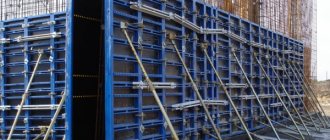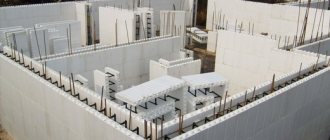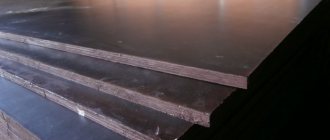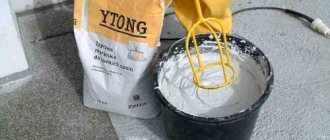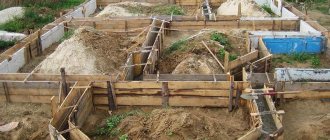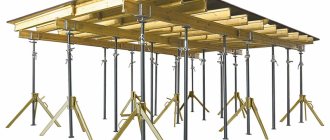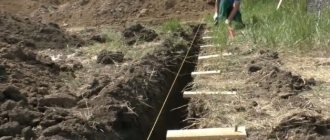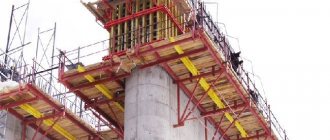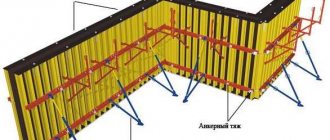Preparatory work
Formwork for a plywood foundation is installed on the prepared surface. To do this, you need to clear the site of bushes, trees, and debris. Soil is removed that cannot be soil capable of supporting the load of the house. The site is leveled to a horizontal level.
The dimensions of the foundation are measured according to the external dimensions and reinforcing pins are driven into the corners. By adjusting the diagonals, the dimensions are clarified, and then internal markings are made, retreating to the width of the foundation. Then they stretch the fishing line along the top of the future fill between the pins, marking all the dimensions. The space for load-bearing walls inside the building is also marked.
Load-bearing frame elements
The entire structure consists of the following components:
- Formwork panels;
- Load-bearing parts;
- Fasteners.
Laminated plywood is used for formwork panels that directly interact with the mortar. The desired shape of the final product depends on their quality. Load-bearing and fastening parts are necessary to fix and connect parts in the desired position.
Floor formwork
Load-bearing parts are often made of steel, which makes it possible to use them many times, disassembling and reassembling the structure to obtain different concrete elements.
When installing foundation formwork, the plywood panels are reinforced with spacers inside, and pegs are driven into the ground on the outside close enough to withstand the pressure of the concrete solution.
Collapsible steel structure
After pouring and hardening of the concrete mixture, parts that do not bear the load are first removed. The load-bearing formwork is removed 10-12 days after pouring, depending on the type of structure, temperature conditions, etc.
Choosing plywood for formwork
For a one-time pour, it will be enough to purchase ordinary coniferous plywood. Moisture-resistant plywood can withstand several cycles. For repeated use, laminated plywood for formwork is used, to which the cement mortar does not stick.
Using plywood for formwork
The standard dimensions of plywood sheets are 2440x1220mm. The sheets should be cut into smaller sizes, which should be slightly larger than the height of the foundation. Their length will have to be adjusted to the location, which is an undoubted advantage of plywood over standard formwork. The thickness of the sheets depends on the width and height of the fill.
To increase service life, the ends of the formwork are treated with waterproof glue. Then the sheets do not delaminate and hold the concrete securely. Coniferous plywood should be coated with drying oil. Then its water resistance will increase. Simplicity of design and high reliability allow developers to erect formwork themselves. It is made by hand. You can rent formwork, but it is constantly needed in the future for the manufacture of fences and outbuildings.
Plywood sheet weight/calculations
The characteristics are required to determine tariffs for processing, transportation and storage of goods. Mass depends on volume and density. Weight is calculated using the formula: m=V (volume) * p (density). The volume, in turn, is calculated as follows: V = Length * Width * Thickness. Density is usually indicated on the packaging. Possible options:
- 600-700 kg/m3 - grades FK, FSF, laminated, and also from birch.
- 450–550 kg/m3 - coniferous wood.
Let's give an example of how to calculate the weight of a sheet of plywood. To do this, we will take birch plywood FSF 6 mm 2440x1220 mm.
- Determine the volume of the sheet in meters: 0.006 x 2.44 x 1.22 = 0.0178 m³
- The number of sheets in a cube is determined by dividing one cubic meter by the volume of the sheet: 1 / 0.017 = 56.179 (number of sheets in m³)
- To determine the weight of a sheet, you need to divide the density by the number of sheets: 680 / 56.179 = 12.1 kg (weight of one sheet).
Plywood weight 1525x1525
| Thickness, mm | 3 | 4 | 5 | 6 | 8 | 9 | 10 | 12 | 14 | 15 | 18 | 21 | 25 | 30 |
| Number of sheets per m³ | 143,33 | 107,50 | 86,00 | 71,67 | 53,75 | 47,78 | 43,00 | 35,83 | 30,71 | 28,67 | 23,89 | 20,48 | 17,20 | 14,33 |
| kg/sheet Birch | 4,7 | 6,3 | 7,9 | 9,5 | 12,7 | 14,2 | 15,8 | 19,0 | 22,1 | 23,7 | 28,5 | 33,2 | 39,5 | 47,4 |
Plywood weight 2440x1220
| Thickness, mm | 4 | 6 | 6,5 | 8 | 9 | 12 | 15 | 18 | 21 | 24 | 27 | 30 | 35 | 40 |
| Number of sheets per m³ | 83,98 | 55,99 | 51,68 | 41,99 | 37,33 | 27,99 | 22,40 | 18,66 | 16,00 | 14,00 | 12,44 | 11,20 | 9,60 | 8,40 |
| kg/sheet Birch | 8,1 | 12,1 | 13,2 | 16,2 | 18,2 | 24,3 | 30,4 | 36,4 | 42,5 | 48,6 | 54,7 | 60,7 | 70,8 | 81,0 |
| kg/sheet Needles/OSB | — | 10,36 | 11,22 | — | 15,54 | 20,72 | 25,90 | 31,08 | 36,26 | 41,44 | 46,62 | 51,80 | — | — |
Plywood weight 1525x3050
| Thickness, mm | 4 | 6 | 6,5 | 8 | 9 | 12 | 15 | 18 | 21 | 24 | 27 | 30 | 35 | 40 |
| Number of sheets per m³ | 53,75 | 35,83 | 33,08 | 26,87 | 23,89 | 17,92 | 14,33 | 11,94 | 10,24 | 8,96 | 7,96 | 7,17 | 6,14 | 5,37 |
| kg/sheet Birch | 12,7 | 19,0 | 20,6 | 25,3 | 28,5 | 38,0 | 47,4 | 56,9 | 66,4 | 75,9 | 85,4 | 94,9 | 110,7 | 126,5 |
Installation of formwork
Trenches are dug to the calculated depth. If the foundation is pile-tape, then wells should be drilled along the bottom of the trenches. After this, the trenches are cleaned again and a layer of sand is filled and compacted at the bottom of the trench and wells. The bottom of the trench is checked with a level.
How to make plywood formwork for a foundation? The formwork is installed as follows. Plywood sheets are placed on both sides of the trench, parallel to each other, along the entire perimeter of the foundation and other places where they are poured under load-bearing walls. They are secured against displacement by spacers, jumpers and braces. The sheets are connected to each other with steel pins. To do this, holes with a diameter of 10 mm are drilled in the plywood. The walls of the holes should be covered with drying oil to protect them from moisture.
Construction of plywood formwork
A plastic corrugated tube is inserted between the sheets along the width of the foundation. To accurately match the distance between the sheets along the width of the foundation, additional wooden blocks are inserted.
When disassembling the structure later, the pin will be easy to remove from the tube. The pin is inserted into the holes and secured with nuts. The side walls of the sheets are reinforced with slats in 2-3 rows. 10 mm holes are also drilled into each rail and the studs are attached along with the rails.
Fastening is done at the top and bottom, along the sheets. For a high foundation, you should skip another rail in the middle. Corner brackets are attached to the side corners with self-tapping screws. All formwork fasteners are installed from the outside so that all surfaces of the sheets inside are smooth. The nails are driven from the inside and bent with a hammer from the outside. This prevents the nails from remaining in the foundation body.
All cracks between the sheets of plywood are sealed to prevent leakage of liquid concrete. To protect the plywood from concrete pressure, additional clamps are put on it. In addition, stakes are driven into the ground from the outside of the formwork and tied together with wire from above. This must be done so that the formwork does not burst from internal pressure.
Removable plywood sheets are easy to install when creating foundations of any configuration. For complex surfaces, figured plywood is used. It is often used when casting stair steps and creating complex curved transitions in a building. Moisture-resistant plywood is most often used for formwork due to its lightness, strength and relatively low price.
To prevent concrete from sticking, a special solution is applied to the internal walls or covered with a protective polyethylene film. The foundation can be made insulated. To do this, sheets of expanded polystyrene are placed between it and the formwork, which remain after pouring and serve as insulation.
Specifications
Typically, sheets with the following characteristics are selected for formwork:
- Standard size 1220x2240 mm or 1250x2500 mm;
- Sheets 18 mm or 21 mm thick;
- Density 650-695 kg/m2;
- High resistance to moisture;
- Well polished surface;
- The maximum bending strength is not lower than 60 MPa.
All of these characteristics make the flooring wear-resistant and allow it to be reused up to 350 times.
Sheets with protective coating
The following properties make it possible to use it for formwork:
- Environmental Safety;
- Ease of processing;
- Lightness of structures;
- Durability and wear resistance;
- Reliability;
- Easy to install using self-tapping screws, nails or glue.
Installation of fittings
Reinforcement is placed inside the formwork and in the well (if any), which is tied with wire. Three reinforcing bars are suspended above the bottom of the trench, and short bars are laid across at intervals of 30 cm, connected with wire. A similar frame is mounted in the middle and at the top of the foundation, attached to vertical posts made of reinforcement. The reinforcement in the foundation strip and in the well zones must also be connected.
Passage openings for communications should be laid in the foundation. They can be made in reserve and in different places. The larger the diameter of the pipes being laid, the better. They will make it possible to adjust the direction and slope. This ensures that the hole is sealed with elastic materials or seals. It is better to separate the water supply and electricity inputs.
Prices
The table shows the price per sheet of plywood made of different materials from different manufacturers:
| Material, manufacturer | Price, increased rub. | |
| Thickness 18 mm | Thickness 21 mm | |
| Sheet size 1220x2440 | ||
| Laminated, China | 1710,00 | 1990,00 |
| Without film, Russia | 1340,00 | 1570,00 |
| Anker Plus, China | 1690,00 | 1990,00 |
| Plywood from Zheshartsky mill | 1880,00 | 2330,00 |
| Verkhoshimensky plant | 1880,00 | 2300,00 |
| Bryansk plant | 2050,00 | |
| Sveza, grade 1/1 | 1960,00 | 2380,00 |
| Sveza DEK, grade 1/1 | 2010,00 | |
| Sheet size 1500x3000 | ||
| Sveza | 2850,00 | |
| Verkhoshimensky plywood mill | 2800,00 | |
Sheets from China are of worse quality.
When analyzing prices, it should be taken into account that Chinese plywood, at a lower cost, has lower strength and wear resistance than similar ones made in Russia.
Pouring the foundation
Pouring concrete is done in several ways. The most labor-intensive, but cheapest method is preparing concrete in a concrete mixer at a construction site. It should be large enough to minimize the number of filling periods. The work is done by a team and continuously. The recipe for the concrete mortar is indicated on paper bags of cement. It is better to use river sand. First, it is poured into the wells, and then into the formwork. The thickness of plywood for formwork should not be less than 12 mm so that it reliably holds liquid concrete.
Filling with a mixer is more expensive, but the operating time and labor costs are much less. The entire foundation can be erected in one shift, which significantly reduces the number of seams. For the mixer, you should provide reliable access and prepare gutters for hard-to-reach places. To prevent concrete from separating, it must be poured in several places. It is necessary to constantly level the concrete, pierce it with reinforcement and tap the formwork to remove air bubbles. A vibrator works best to remove air from concrete. Particular care should be taken to compact the concrete at the junctions of the reinforcement.
After finishing the pouring, the surface of the foundation must be smoothed and covered with a film to prevent it from drying out. The hardening of concrete continues for four weeks and during this time it must be periodically moistened. Then the formwork is removed and waterproofing is carried out. Thus, by making plywood formwork with your own hands, you can ensure reliable pouring of a high-quality foundation.
Turnover
Turnover is a special indicator that shows the ability to use formwork once or repeatedly. Typically, disposable formwork is permanent; it remains in the foundation or wall after the mortar has hardened. Reusable, on the contrary, is a structure into which concrete can be poured several times. The more times a structure can be reused without irreversible changes, the higher the formwork turnover rate.
Plywood can be reused many times
Turnover depends on the type and quality of the material produced and operating conditions. Formwork made from wooden materials is considered the most unreliable due to the fact that the material absorbs moisture very quickly and deforms. For wooden structures, birch, deciduous, and pine boards are chosen. In order for the material to be used several times, boards of class 1-2 are selected, with a thickness of 20-32 mm and a humidity of no more than 25%. In addition, to reduce the absorption of moisture by the material, the boards are treated with lubricant.
In this regard, the use of bakelite plywood for formwork makes it possible to obtain durable, reversible structures. Unfortunately, the price of such material is high, so only large construction companies can afford it. Therefore, production often takes place from grade 3-4 PSF. Its cost is lower, but it also wears out quite quickly.
Today, during construction, they use the rental service of plywood for formwork. This is due to the fact that the cost of the formwork structure is up to 40% of the cost of concrete structures. For small-scale construction, this service is indispensable, because the rental price is much lower than the cost of a new one.
Did the article help you? ( 4 ratings, average: 3.75 out of 5)
Advantages of using plywood for formwork
Plywood formwork has several advantages over wooden panels:
- it has a high deformation threshold, therefore concrete elements are not deformed. It is important to use vertical supports every 60–100 cm
- the ability to obtain a smooth surface without joints
- This formwork can be used repeatedly. Moreover, it is easy to adjust directly on the construction site
installation of plywood formwork is less labor-intensive, panels can be knocked down faster than in the case of boards
Recycling plywood
After the formwork has been removed, the plywood must be cleaned and dried. It can then be reused.
Recycling options:
- It can be used on another object
- Use it as a subfloor or ceiling
- Plywood formwork can be sold
What distinguishes good formwork from bad
Previously, in private construction, basically everyone used exclusively edged coniferous boards nailed into panels. This material is quite worthy for not too demanding work (or for one-time tasks). The most important advantage of this solution is that the edged board is inexpensive, especially if it is of 2 grades, which, by the way, also fits well and has a low price.
Plywood for formwork - laminated
But if it is necessary to make several monoliths, or when it is important to pay special attention to the quality of the treated surfaces, then they order plywood or, as an option, OSB boards.
Shaping function
The primary task of formwork construction is to create a form. The liquid concrete mass should fill the space in artificially created fences, where, at the end of the maturation process, the concrete will completely harden and gain its design strength.
The accuracy of the geometric dimensions of the finished monolith depends on how accurately the formwork is assembled, how smooth and stable it is. In many ways, we are also talking about the smoothness of surfaces. Boards nailed together into a board, even with well-cut edges, leave convex “stripes” on the concrete, since there are always some gaps between them. In the case of using plywood, there are gaps only at the junctions of the boards; there are no joints along the plane of the board that affect the quality. Plywood, as a large-format product with sides of 4, 5, 8, 10 feet, allows you to create a one-piece formwork panel.
Do not forget that in many cases it is important that the concrete not only be free of large irregularities, but also have a smooth surface. A board board cannot provide this (there is a natural texture with annual rings, there are defects/traces from sawing on the faces, there are knots or cracks...), but sanded plywood (or even more so laminated) is easy!
Strength characteristics
The next task of a good formwork is to withstand a huge multi-ton load, which turns out to be the weight of the concrete laid inside.
In addition to the static weight of concrete pushing and pressing down, one should also take into account the forces that arise during the vibration of the concrete mass. The fewer connections, the fewer problems. In addition, for formwork, plywood is preferable to boards due to the stability of its physical properties, because it is assembled from several layers of veneer in a workshop, its density and strength are always the same, and the presence of defects and defects is strictly controlled. Hence the high repeatable load-bearing capacity of the plywood sheet compared to edged lumber.
Weight and compactness
Another positive side of using plywood for formwork is the reduced weight of the structure (with similar strength, plywood will be thinner than a board). It should also be noted that to make boards from boards, you will have to use a larger amount of edged timber, which is used to strengthen and expand the formwork. This also affects the price and the total weight of components for the shield.
Preservation of the monolith
The protective function of formwork is often not taken into account by people when choosing materials. However, the formwork structure must prevent the concrete from freezing during curing, or from drying out during heat.
High-quality formwork should prevent liquid cement milk (which greatly affects the strength of the resulting cement stone) from leaking out of the mold. And again, here plywood will be practically unrivaled; it has the necessary thermal insulation ability and creates few joints.
Ease of use
When assessing the suitability of materials for use in formwork, one must also take into account the practicality of the panel. For example, it is important to know how easy it will be to remove formwork from mature concrete. A smooth plywood panel (especially if it is lubricated) can be easily removed, it will not leave marks on the monolith, it will not cause cracks, since it will not require the use of excessive force.
Needless to say, working with large sheets of plywood is always easier and faster than with piece-edged boards that need to be adjusted, joined, and secured as part of the panel.
Resistance to aggressive conditions
The poured concrete remains liquid for a long time; after hardening it will still be wet. Therefore, the formwork is constantly exposed to intense moisture during use, which easily spoils, for example, metal sheets, and also has a strong effect on wooden boards, which without protection (from film or painting) begin to swell, crack, and rot.
FOF plywood - laminated for formwork
Laminated plywood 1220x2440 mm format
Reusable laminated plywood formwork
That is why plywood with increased moisture resistance, as well as plywood protected by a laminated layer, is most often purchased for formwork. In addition to moisture, the working surface of the formwork panel is affected by the acid-base environment of the solution, and it is also necessary to somehow protect the materials from it. Only high-quality lamination can cope with this.
What kind of plywood is used for formwork?
Plywood is divided into types depending on what glue is used in its production. For the construction of formwork, the following types of this material are used: FBA, FSF, bakelized plywood.
This is a type of plywood in which layers of veneer are glued together with albumin casein glue. This makes it environmentally friendly and places it among natural materials. It can be laid in residential areas. However, it is not the best option for repeated use as a formwork material, since it is not resistant to moisture.
This type of plywood is moisture resistant. The layers in it are glued together with phenol-formaldehyde resin, which determines its moisture-proof qualities. It is recommended to be used for outdoor work, including the creation of formwork. It will withstand many cycles of use. Phenol-formaldehyde resin is toxic, so using such plywood indoors is not environmentally friendly.
Laminated plywood
A laminating layer on the surface of plywood improves its moisture resistance. Typically, FSF plywood is laminated from hardwood, usually birch. Such plywood can have a smooth or corrugated surface, giving it anti-slip properties. It is laminated plywood that is often used for formwork.
Non-laminated plywood can be unsanded or sanded on one or both sides. The main purpose of grinding is to improve the aesthetic qualities of the material. It also eliminates minor surface defects and, as a result, makes the material more resistant to mechanical damage - chipping and warping.
Bakelized plywood
Its layers are glued together with bakelite resin. It gives the material special strength and resistance to aggressive environments. Thanks to this, it can be used in different climatic conditions. Bakelized plywood can withstand temperature changes, even significant ones - from -50°C to +50°C. It is used in humid tropical climates and conditions of the far north. If construction takes place in one of these regions, this type of plywood is ideal.
Russian or Chinese plywood?
The domestic market offers plywood from Russian, Finnish and Chinese production. The first two practically do not differ from each other in quality; plywood of some Finnish brands is even produced in factories in Russia. At the same time, the cost of the Russian one is significantly lower. Chinese plywood can be used in low-rise construction as an economical option. Its quality is low. It is not suitable for repeated use in multi-story construction.
Is there a price alternative?
If you are not interested in reusing building materials, then laminated plywood for used formwork is more suitable for you, which you can also buy in Moscow from our company. The cost of a sheet will vary from 560 to 1,200 rubles/sheet. This gap in the price of building materials is associated with the manufacturers of plywood for formwork and its characteristics (true for both new and used boards).
High-quality laminated plywood for formwork is a multi-layer board covered on both sides with a special polymer film. It is resistant to both moisture and mechanical damage. Therefore, this type of building material is considered the most durable among existing types of plywood (FK, FSF, etc.). Unused plywood laminated for 18 mm formwork, the price of which also depends on the grade of the material, can be used from 65 to 95-100 times. When using sheets under harsh conditions, turnover is reduced to 56-70 times. In our catalog we present laminated used plywood for formwork with a working life of 45-55 revolutions. The shorter the resource (tested by tests), the lower the price of the building material. For laying a strip foundation, this slab resource is quite sufficient.
